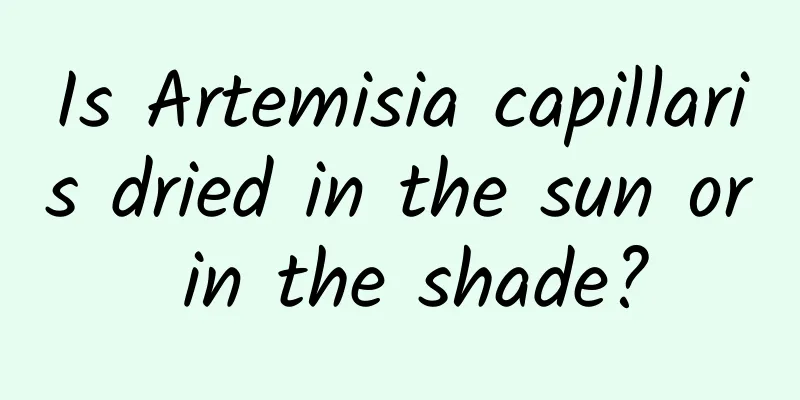Is Artemisia capillaris dried in the sun or in the shade?

|
Artemisia capillaris is a common Chinese medicinal material grown on hillsides in southern regions. However, due to its difficulty in preservation, it must be dried and preserved after being picked. Due to the characteristics of each type of Chinese medicinal material, different methods must be selected when drying and preserving this type of Chinese medicinal material. Generally speaking, there are two drying methods for Chinese medicinal materials: sun drying and shade drying. So, is Artemisia capillaris dried in the sun or in the shade? After washing and drying the Artemisia capillaris, seal it in a plastic bag and store it in a cool and dry environment, avoiding light and insects. 1. Aliases and sources: Artemisia capillaris, Artemisia capillaris, Artemisia argyi, Artemisia argyi. It is the dried above-ground part of Artemisia sphaerocephala or Artemisia capillaris of the Asteraceae family. 2. Origin: Grown on hillsides and roadsides. Distributed all over the country. It is mainly produced in Shaanxi, Hebei, Shanxi and other provinces. The commercial product is generally known as Mian Yinchen, and the one produced in Shaanxi is called Western Yinchen, which has the best quality. 3. Identification of properties: Artemisia capillaris seedlings are mostly curled up, with the whole plant densely covered with white hairs and gray-green color; the leaves are mostly split into threads and soft like velvet; they have a slight fragrance and a slightly bitter taste. The seedlings are curled up into a ball and are grayish white, grayish green or grayish yellow (after long-term storage). The whole body is densely covered with grayish white or grayish yellow silky hair, soft like velvet. The stem is small, 1.5 to 2.5 cm long and 1 to 5 mm in diameter. Obvious longitudinal lines can be seen after removing the surface hairs. It is brittle and easy to break. The leaves are petiolate, and when flattened, they are deeply pinnate or palmately fissured 2 to 3 times. The leaves are 1 to 3 cm long and about 1 cm wide. The lobes are ovate, obovate or oblanceolate, linear, and have sharp tips. It has a light fragrance and a slightly sweet taste. The best ones are tender, soft, grayish white in color and have a strong aroma. 4. Nature, flavor and meridians: Bitter, pungent, slightly cold. It enters the spleen, stomach, liver and gallbladder meridians. 5.Performance characteristics: This product is bitter and cold-purging, and can clear away dampness and heat in the liver and gallbladder, promote bile secretion and reduce jaundice. 6. Efficacy and indications: Clears away heat and dampness; reduces jaundice. Indications: jaundice; difficulty urinating; itching due to wet sores, etc. 7. Usage and dosage: 6~15g. Apply appropriate amount externally and decoct it for fumigation and washing. 8. Notes: Excessive dosage of Artemisia capillaris can cause dizziness, nausea, diarrhea, upper abdominal discomfort, acute liver and gallbladder damage, and there are also reports of arrhythmia. However, therapeutic doses of Artemisia capillaris generally do not cause serious damage. |
<<: The difference between Tibetan Artemisia capillaris and Artemisia capillaris
>>: How to store fresh Artemisia capillaris
Recommend
Can I use a fan during my period?
For women, they must not catch a cold during mens...
What causes intestinal spasms? Causes of intestinal spasms
Intestinal spasms, a gastrointestinal disease, ar...
Tong Ren Tang Chaihu Shugan San
Many people know that Scutellaria baicalensis is ...
How to cure hemorrhoids quickly
Hemorrhoids are the most common perianal disease....
How to get rid of oily hair
With the continuous improvement of modernization,...
What causes male vulvar itching?
When it comes to vulvar itching, many men think t...
The most powerful anti-tumor Chinese herbal medicine
Some Chinese herbal medicines have excellent anti...
Benefits of Lotus Seed, Chinese Yam and Gorgon Fruit Soup
Lotus seed, yam and water chestnut soup, as the n...
What fruit is better for constipation caused by internal heat?
Many people are prone to getting angry because in...
Back spine protrusion
If the human body is compared to a building, then...
What are the symptoms and warning signs of chronic nephritis?
Chronic nephritis is a type of kidney disease. Mo...
How to take Chinese medicine twice a day
Choosing the right time to take Chinese medicine ...
Is cod liver oil good for babies?
In fact, cod liver oil is good for the health of ...
Sanjie Zhentong Capsule
People cannot live without medicine in their dail...
What causes stomach cramps?
Convulsion, also known as cramp. Abdominal cramps...









